Scroll through the lesson and click on notation/video/audio links to load the interactive players.
Please subscribe to get full access to all lessons for only $7.95/month PLUS 1 week free trial.

Riff Interactive lessons are
LESS expensive and
MORE interactive than alternatives!
More Info
|
|
| Lesson Subject:
Understanding Chords |
| What you learn:
More Extended Chords |
| Teacher: Michael Johnson |
Michael:
In this lesson on Understanding Chords you'll learn the formula for the Dominant
& Minor Chords/Arpeggios. There isn't enough time to cover all the chords, but
we'll go over the general concepts so you get a better understanding of how each
of these formulas are broken down.
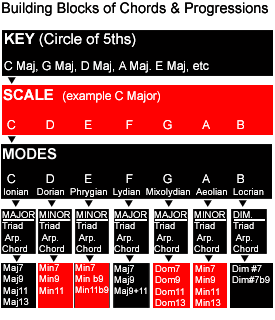
Michael:
Here's the formula for the coming chords
and arpeggios. For now we'll go over the DOMINANT chords/arpeggios, use the
chart below as a reference to understand how the MINOR chords are built.
Chord
Chart 1

Michael:
Notice the CHROMATIC scale is first. The MAJOR scale is actually a derivative
from this scale as is is for the other scales. It's
like playing all the notes on your guitar or all the black and white keys on a
keyboard. Now look for the FORMULAS, what notes would be in the C MAJOR
chord?
coors:
ceg
Kelly:
CEG
Michael:
Very good, does everybody understand
this so far?
Glenn: yes
Michael: OK what are the notes for the C
Maj7?
coors:
cegb
Kelly:
CEGB
Michael:
Great, the chart is a good reference for
you, what about the C Maj11?
Kelly: CEGBDF
Michael:
Yes Kelly, now we get to the next part,
what is in the C dom 7?
Kelly: CEGBb
Michael:
Great!
sds:
cegBb
Michael:
Here's a tab notation that will help you
visualize the first chart. First here's the C Chromatic and the C Major
scale.
Michael:
Do you see
how the C Major scale comes from the C Chromatic?
Glenn: yes
rockman: yep
Michael:
You have a whole bunch of notes and you
only select 7 notes from that pattern. Once you have the Major scale
you can break it down into the arpeggio and chords.
coors:
So is
chromatic basically all of the notes in a Single scale?
Michael:
You bet coors, now the C major scale can
be broken down into an arpeggio. Using the formula chart I sent earlier C Maj -
1, 3, 5, OK a CHORD is the same notes as the ARPEGGIO but you play them all
at the same time, in this case you'll omit a few notes from the arpeggio.
Michael:
CEG, OK now let's learn the DOMINANT
formula.
Chord Chart
2
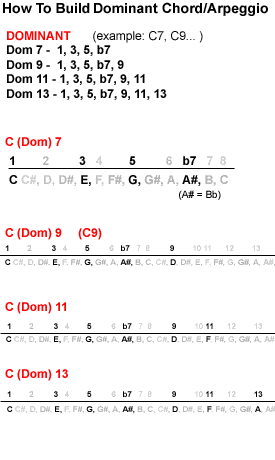
Michael:
Now by looking at this chart what are
the notes in the C7 chord/arpeggio?
Kelly: CEGBb
Michael:
Great! Can everybody see how that
works?
Glenn:
yes
coors: A
little, i guess i just need to memorize the formulas
Michael:
It's basically a math formula. In math we learn formulas in music it's the same thing. You can use
reference charts, it's kind of a shortcut. What are
the notes used in the C (dominate) 9
chord?
Kelly:
CEGBbD
Michael:
Yes Kelly, we'll let's break this into
tab so you can see it on the fretboard.
Michael:
First you
have the C major scale, then you see the C7 arpeggio with the b7 note
(F#), OK, now here are various positions of the C7
chord:
Michael:
Here are some images of the fingerings.
C7 - Chord
1
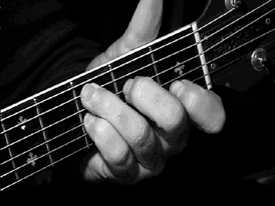
C7 - Chord 2
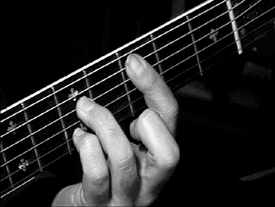
C7 - Chord
3
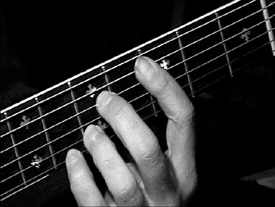
C7- Chord 4
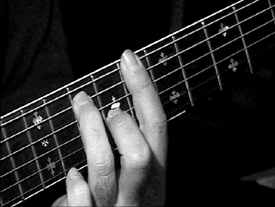
C7 - Chord 5

ginger: C maj9 would be 1 3 7
9
Michael: That would
be 1, 3, 5, b7 9.
Kelly: OK, so eliminate any repeats in favor of
different notes in the chord.
Michael:
You bet Kelly see how you can alter the
C7? Just as long as you have the 1, 3, 5,
& b7 in it you can come up with all kinds of variations. Here's the C
Dom 9.
Michael:
See how the
C9 works, you add the extra note. Here's 2 chord
positions.
C9 -
Chord 1
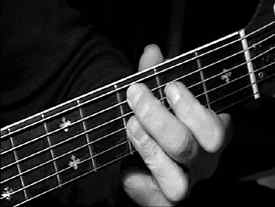
C9 - Chord 2
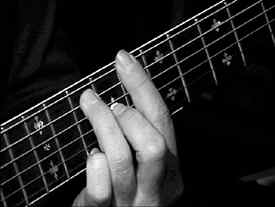
jlancaster: How would you know what chord someone is
playing ie C7
Michael: JL, after playing and listening to
the chords and arpeggios for awhile you'll learn to recognize the chords played,
for instance the 9 chord to me has a "funky" sound to
it.
rockman: I
just use my ear, like teach says....you'll learn the different 'flavours' of a
chord sound.
Michael:
You bet rockman.
Kelly:
The problem is that there are too many 'flavours' to chose
from!
Michael:
Start with basics Kelly, then work your way
up.
rockman: Play them constantly, until you've trained
your ear....time will tell all.
Michael: OK, here's the
C11.
C11
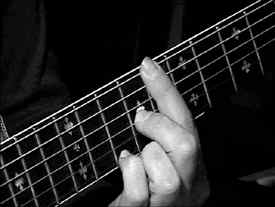
Michael:
And the C13.
C13
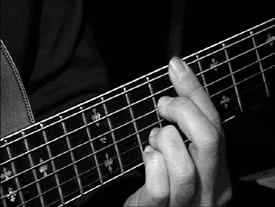
Michael:
Here's some basic things in the
flavor of these chords to listen to the dom 7 and dom 9, both chords have a
funk/blues feel. The dom 11 and dom 13 have a jazz sound to
them.
Kelly: The
dom 13 sounds almost like random notes to my ear, I have to double check each
finger just to make sure I'm playing it right.
Michael:
We don't have time to cover MINOR
but I'm going to give you a live listening test. I'm going to create some audio
files live and you guess what chords I'm playing, ready to play the listening
game?
Dana:
yeah
gully: you
bet
Michael: Guess what chord
this is:
Sound
Clip 1
coors: C9
Kelly: It's
got at least a 7th
Michael:
You rock coors! You got it, it's the
C 9. Here's another.
Sound
Clip 2
ginger: C13
rockman:
Sounds like 13
Michael:
Yes!!! It's the C13, good ears!
rockman:
very top heavy sound.......bright
Michael:
Try this
chord:
Sound Clip
3
rockman:
7
gully:
13
Michael:
Yes rockman! You're the man! it's a
dom7. You can hear this chord in many rock
songs as well like in songs like Wully Bully, or bands
like the Chilli Peppers, Beatles etc. This is what you call
ear training, Try this one:
Sound Clip 4
rockman: Is that
11?
Kelly: I'll
go 11.
Michael:
No, it's the 7th
again.
Kelly:
D'oh! Suckered me in.
Michael:
Good try though. Well class time to go, I hope you
learned a lot of new things.
lebaron: Thanks, this is helpful and
interesting
rockman: Thanx teach....that was fun
:)
emily: Thank
you so much for the lesson
lebaron: Bye all, see you next
time
Michael:
See you next
lesson!
|
<< load notation from left
|
|
<< load audio from left
|
<< load audio from left
|